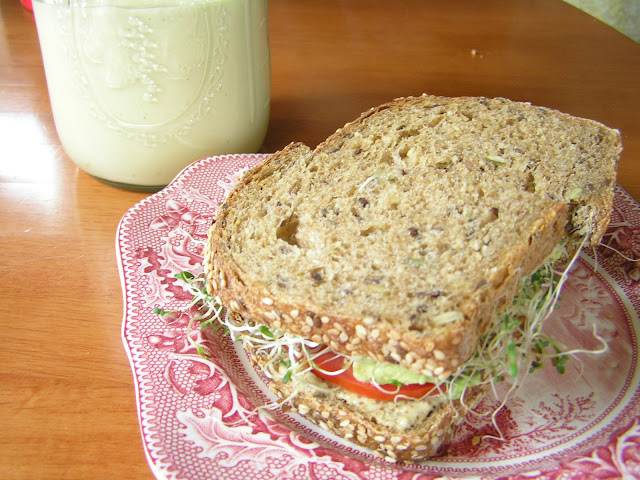Making Fresh Mayonnaise That Keeps

Once I realized I could make our own mayonnaise so easily, I felt pretty committed to never buying the store-bought kind again. We like doing things ourselves: We know what's in it - we never have to read food labels and wonder what they really mean - and we can make it exactly how we want. That storebought stuff was iffy, but I'm confident this raw, fresh mayonnaise is actually good for my family.
Olive oil mayonnaise has a stronger flavor than canola, soy, or safflower mayonnaise, but you get used to it pretty quickly, and even come to appreciate its flavor contribution on sandwiches. I found that using more egg and less oil in my recipes helps to neutralize the flavor so it's mild enough to work for all our mayonnaise needs. Of course we throw in garlic as well because garlic is delicious, and it's antimicrobial properties probably help fresh mayo keep longer as well. Feel free to use whatever oil you like for your homemade mayonnaise.
I'd tried making my own mayonnaise twice in the past: Once, successfully, from a Joy of Cooking recipe for aioli. It was great, but we didn't use it up soon enough and it went bad. The next time, in more recent years, my emulsification failed and, not knowing how to fix it, I dumped all those great ingredients because they were in an unusable slurry, and vowed to leave mayonnaise making to the professionals.
Well, I'm pretty much done leaving anything to the professionals. Every organic mayo we've found in stores has soy oil in it, or other iffy oils, and the only soy free mayonnaise choices are non-organic. We've been making do with store-bought for so long now because I thought it was beyond me to make a decent mayonnaise myself. Glad to be wrong!

Making It:
You can mix the ingredients with a food processor, a blender, or an immersion blender. Or, if you're way burlier than I am, use a whisk. Or a fork! Whatever you use, be prepared to stick with it for several minutes of intense mixing.The secret to successful emulsification is to pour the oil in so painfully slowly; it should take minutes, and start with only the thinnest stream. I used to have Nik do this part because he's way more patient than I am. If it still fails to emulsify, or bind the egg and oil together, I've read that you can save it by blending in more eggs before adding the rest of the oil. I haven't had to try this, but I'm very glad to know there's a method to rescue a botched batch.
Another trick that helps to get nice, spreadable mayonnaise is to blend it for several minutes, way longer than you might think necessary, until it's nice and thick. So, blending as you go, slowly pour up to 1/4 of the oil in with the eggs. Then stop adding oil and just blend until emulsification is obviously happening and the mixture is thick. Then you can more quickly add the rest of the oil. Never rush it, especially if you are just learning how.

Making It Last:
So, making fresh mayonnaise successfully is really not that hard, but most of us are used to a mayonnaise that keeps for longer than 4 days, and the fresh stuff should really be used up fairly quickly. However, longer term freshness can be achieved through lacto-fermentation!Lacto-fermentation is a controlled process of growing certain beneficial micro-organisms, which inhibit the growth of others, thus ensuring a longer-lasting mayonnaise. When I make fermented mayonnaise it keeps for a few weeks, while the unfermented stuff keeps only a few days. The flavor of the mayonnaise doesn't change, to my palate anyway, during fermentation.
Fermenting mayonnaise involves simply adding some ginger bug, aka lacto-fermented soda starter, or kombucha, or some raw whey from cheesemaking if you have it. If you don't have any of these ingredients and you just want to make some fresh mayonnaise to eat within 4 days, you can use vinegar in the recipe instead. This recipe makes about 3 cups of mayonnaise.
How to:
Blend 3 eggs until creamy (use the best, freshest eggs you can get)Ever so slowly, trickle in 2 c olive oil
Blend until soft peaks form, several minutes if needed
Add 2 cloves garlic
1 t sea salt
If fermenting, add 2 tb kombucha, ginger bug, whey, or raw apple cider vinegar (follow the above links to make your own)
Blend well and place in jar. Use within 3-5 days, or proceed with fermentation:
In this case, fermentation does not take long. Cap tightly and leave at room temp, out of direct light, for about 7 hours. This will preserve it for about 3 weeks.

Ketchup, mustard, and mayonnaise, all lacto-fermented!
Below are Amazon Affiliate Ads. Any purchase made through them helps support our family. Thanks in advance!














